Capital Allowances on Cars: A Quick Guide for UK Businesses
Claiming capital allowances on company cars can cut your taxable profits—but the rules depend on CO₂ emissions, price, and vehicle type. Here’s what you need to know:
- Eligibility and Pools
Company cars aren’t covered by the Annual Investment Allowance. Instead, they go into one of two capital allowance pools: the Main Pool (standard assets) or the Special Rate Pool (cars with higher emissions). Your allowance depends on which pool your vehicle fits.
- Emission-Based Rates
Cars emitting ≤50 g/km of CO₂ qualify for 100% First-Year Allowance, letting you deduct the full cost in year one. Vehicles over this threshold enter the Special Rate Pool (6% writing-down allowance) if emissions exceed 50 g/km, or the Main Pool (18% writing-down allowance) otherwise.
- Writing-Down Allowances (WDA)
If your car doesn’t qualify for first-year relief, you claim a WDA each year on the pool balance. The Main Pool rate is 18%, so you deduct 18% of the remaining value annually. The Special Rate Pool drops at 6% per year, spreading relief over a longer period.
- Impact of Business Use
Only the portion of car costs and allowances that relate to genuine business use can be claimed. Keep detailed mileage logs and business-/personal-use records. HMRC may disallow relief if your records are incomplete or if private use is significant.
- Disposals and Balancing Charges
When you sell or dispose of the car, compare the sale proceeds to the pool’s written-down value. If proceeds exceed the pool balance, a balancing charge adds back excess to your taxable profits. If lower, a balancing allowance gives extra relief.
Conclusion
Understanding how cars slot into capital allowance pools and following emission-based rates can unlock significant tax relief. Track business miles carefully, choose low-emission vehicles to maximise first-year write-offs, and review disposals to manage balancing adjustments.










